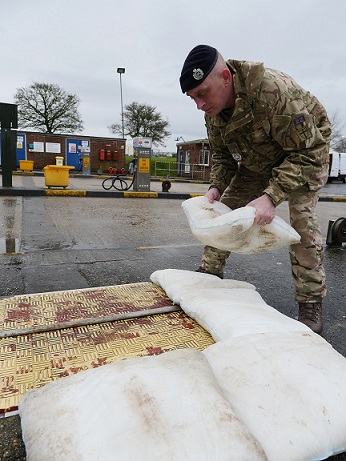 FloodSax alternative sandbags can hold back a torrent of floodwater
FloodSax alternative sandbags can hold back a torrent of floodwater
 A soldier deploying FloodSax sandless sandbags
A soldier deploying FloodSax sandless sandbags
What causes thunderstorms and where are they most likely to strike in the UK?
The main trigger to thunderstorms is warm air … and the gigantic clouds that produce thunderstorms store the same amount of energy as 10 Hiroshima-sized atom bombs.
Although the north is more commonly associated with rain, according to the Met Office most thunderstorms happen across the East Midlands and the southeast in the UK.
And as heavy rain often accompanies thunder and lightning, many homes and businesses need to be prepared 24 hours a day against flash flooding with flood barriers such as FloodSax alternative sandbags (www.floodsax.co.uk) which are far easier to store and deploy than traditional sandbags.
The Met Office says that thunderstorms develop when the atmosphere is unstable with warm air beneath much colder air. As the warm air rises it cools and condenses, forming small droplets of water and the water vapour can quickly form huge cumulonimbus clouds – the only clouds that can produce hail, thunder and lightning - and can stretch as high as 20,000ft above the ground. Unbelievably, according to the Met Office they store the same amount of energy as 10 Hiroshima-sized atom bombs.
Cumulonimbus clouds are associated with extreme weather such as heavy torrential downpours, hail storms, lightning and even tornadoes.
An average thunderstorm lasts for 30 minutes and is about 15 miles wide.
So what causes lightning?
The Met Office says that as the warm air continues to rise into the colder air above it the water droplets combine to create larger droplets which freeze to form ice crystals. As a result of circulating air in the clouds, water freezes on the surface of the droplet or crystal. Eventually, the droplets become too heavy to be supported by the updraughts of air and they fall as hail.
As hail drops through cloud, it picks up a negative charge by rubbing against smaller, positively charged ice crystals - just as rubbing a balloon can create static electricity. A negative charge forms at the base of the cloud where the hail collects, while the lighter ice crystals remain near the top of the cloud and create a positive charge.
The negative charge is attracted to the Earth’s surface and other clouds and objects. When the attraction becomes too strong, the positive and negative charges come together - or discharge to balance the difference - in a flash of lightning. The rapid expansion and heating of air caused by lightning produces the accompanying loud clap of thunder. This means that a thunderstorm must have lightning as the thunder is caused by lightning.
Considering light travels very fast – about 300 million metres per second and that sound only travels at 300 metres per second - light is a million times faster than the sound produced. To find out how far away the storm is, you can count how long you hear the sound after the lightning. For every 4 seconds between the flash and the rumble the thunderstorm is one mile away.
Thunderstorms are created by intense heating of the Earth’s surface so they are most common in countries where the weather is hot and humid. It also means more thunderstorms happen over land rather than the sea.
Lightning factfile
* A lightning strike hits somewhere on the Earth’s surface approximately 44 times every second, a total of nearly 1.4 billion lightning strikes every year.
* At any time there are more than 2,000 thunderstorms happening worldwide.
* Each lightning flash is about 3 miles long but only about one centimetre wide.
* Lightning heats the air around it so it’s much hotter than the surface of the sun. Lightning can get up to 50,000°F – that’s 5 times hotter than the sun. To put it even more into context, lava is 2,240°F.
* A single lightning bolt unleashes as much energy as blowing up a ton of TNT.
* A lightning strike is actually made up of between three and twelve individual lightning ‘strokes’, each lasting only a few thousandths of a second.
* Your estimated odds of being struck by lightning in an 80-year lifespan are 1 in 13,000 and, yes, those are higher odds than winning a fortune in the lottery.
Here’s what you should NEVER do during a thunderstorm
Avoid bathtubs, swimming pools and, if you are fishing or swimming, get out of the water straight away as it is extremely dangerous during a lightning storm.
Never seek shelter under a tree or near power lines as they are both conductors of electricity and could cause serious injury or death.
Don’t use your mobile phone during a thunderstorm.
If you are not near any buildings, a car with a metal roof and side is the next best thing.
If you are outside and cannot find shelter, get into a ‘lightning crouch’ by squatting down with your feet together, your head tucked to your chest or between your knees and your hands covering your ears or flat against your knees.
Do not lie flat on the ground as this will give the lightning a larger target.
Don’t wash your hands, shower, wash dishes or do laundry. Metal pipes in the plumbing can also conduct lightning.
Avoid using corded phones and electronics such as computers or power tools. Electrical wires can conduct lightning.